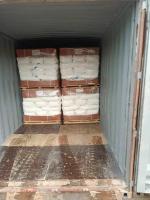Our Products
Polyacrylamide / cationic granular polymer praestol 610BC 321TR 611BC can be replaced by Chinafloc C


These three belong to the Praestol series of flocculants, which are cationic, high–molecular weight polyacrylamide derivatives supplied in granular (powder) form. Below is a comprehensive breakdown of their applications across industries:
Praestol 610BC, 321TR, and 611BC are widely used in municipal sewage treatment plants for clarifying wastewater and conditioning sludge.
Sludge Dewatering:
These cationic granular polymers are dosed before centrifuges, belt presses, or chamber filter presses to improve sludge cake dryness. They help form large, dense flocs that release bound water, reducing the final sludge volume and lowering disposal and transportation costs.
Primary and Secondary Clarification:
In primary treatment, they enhance the sedimentation of suspended solids. In secondary biological treatment, they assist in settling activated sludge, preventing bulking and improving effluent clarity.
Different industries generate effluents with high turbidity, organic load, or emulsified contaminants. Praestol 610BC, 321TR, and 611BC are chosen depending on the charge density and molecular weight required.
Food Processing: Aid in removing proteins, fats, starches, and organic matter, producing clearer discharge water.
Textile Industry: Used for decolorization and removal of fine fibers from dyehouse effluent.
Petrochemical and Refining: Help separate oil-in-water emulsions and stabilize sludge for easier treatment.
Pulp and Paper: Enhance fiber recovery, improve white water clarity, and support recycling of process water.
In both municipal and industrial facilities, sludge thickening is a critical step prior to dewatering. The Praestol granular cationic polymers are added to sludge before gravity thickeners or flotation thickeners. Their role is to produce compact flocs that separate quickly, thereby increasing the solids concentration and reducing downstream dewatering loads.
While cationic polymers are less common than anionic types in potable water, Praestol cationic grades can be applied when raw water contains negatively charged colloids, organic matter, or algae. Their action improves turbidity reduction and enhances filtration efficiency in sand filters or membrane systems.
Cationic granular polymers also find specialized uses in mining operations, especially where tailings streams or beneficiation processes involve fine, negatively charged particles. They improve tailings thickening, water recovery, and reduce the volume of slurry requiring long-term storage.
Praestol 610BC, 321TR, and 611BC can be applied to agricultural waste streams, slaughterhouse effluents, or starch industry wastewater. Their action enables faster clarification, improved water recycling, and easier handling of nutrient-rich sludge.
High Efficiency: Strong cationic charge ensures rapid destabilization of negatively charged colloids.
Reduced Costs: Better dewatering performance decreases sludge transport and disposal costs.
Operational Flexibility: Powder (granular) form offers easy storage, stable shelf life, and suitability for preparation of polymer solutions on-site.
Environmental Compliance: Facilities can meet stringent discharge regulations by achieving clearer effluent and reduced pollutant loads.
Praestol 610BC: Often used in municipal sewage plants for sludge dewatering due to balanced molecular weight and charge.
Praestol 321TR: A versatile grade with slightly different charge density, applied in both municipal and industrial wastewater.
Praestol 611BC: Typically offers stronger cationic character and is chosen for more difficult-to-dewater sludges or higher solid loads.
✅ In summary: Praestol 610BC, 321TR, and 611BC are cationic granular polymers mainly applied in municipal wastewater treatment, industrial effluent treatment, sludge thickening and dewatering, drinking water clarification, and certain mining processes. Their primary role is to neutralize negative charges on suspended solids, form strong flocs, enhance sedimentation, and release bound water from sludge, leading to improved treatment efficiency, cost savings, and regulatory compliance.


